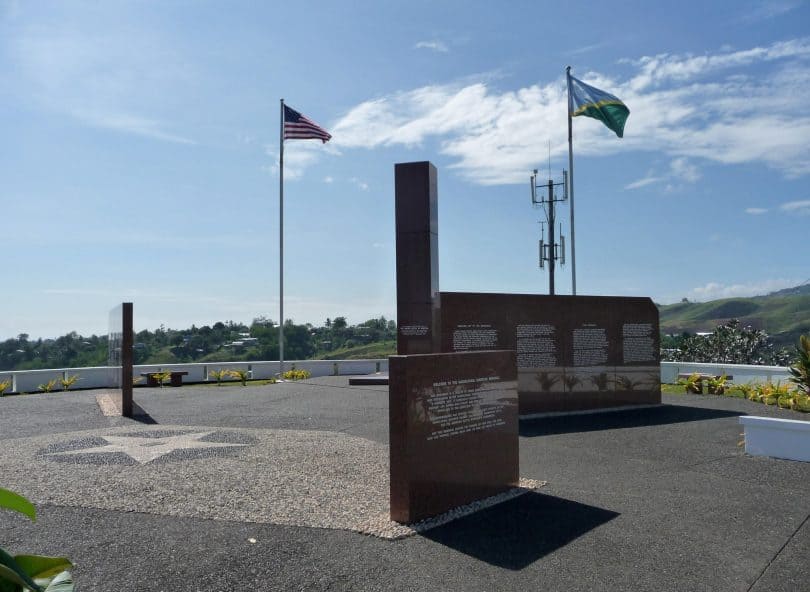American diplomats and dignitaries have assembled in Honiara for the 80th anniversary of the Guadalcanal Landings during World War II (WWII). Recent developments, including the China–Solomon Islands security agreement along with numerous news and media stories, are casting a long shadow over this year’s gathering. There is no doubt these recent events are responsible for the high-level U.S. representatives attending the commemorative service on Skyline Drive.
Concerns about Beijing’s move into Solomon Islands are legitimate, but Chinese involvement is not new, nor is it sudden in development. China has been making overtures in the Pacific for over a decade. In response, U.S. foreign policy has repeatedly stated that the U.S. will pivot towards the Pacific. But we are yet to see it.
What can the U.S. do to move from a relationship with Solomon Islands based on the past to a relationship that meets the challenges of today and looks towards the future? How can Americans remember the soldiers, marines and sailors who served, and those who never came home, while providing a foreign policy relationship that will resonate with the Solomon Islands people?
We can no longer fall back on our shared WWII (Bikfala Faet) history as the sole basis for our relationship with the country. I say this as a member of an American family who lost someone to Iron Bottom Sound during WWII. My mother’s 17-year-old brother was lost at sea during the Battle of Savo Island. My family history brought me to Solomon Islands 18 years ago; but the issues the people currently face keep me here.
The best thing the U.S. can do to counter concerns about China is to develop partnerships with the people of Solomon Islands that strengthen health and education.
As a physician, I have visited hospitals and clinics throughout Solomon Islands and I have worked extensively at the National Referral Hospital (NRH), also known as Number Nine. The NRH stands where the 9th Army Field Hospital was during the Guadalcanal campaign. The oldest buildings on the hospital campus, made from timber, date back to the late 1950s and early 1960s, when the original hospital was built. Additional buildings were added in the 1970s and 1980s. The current main hospital building was built in 1993 by Taiwan.
The NRH plays a critical role in providing advanced medical and surgical care to the people of Solomon Islands. As the country’s tertiary care hospital, NRH receives patient referrals from 12 smaller, outer island provincial and church-supported hospitals, as well as hundreds of rural clinics.
But its buildings are deteriorating, subject to the damages of a harsh tropical environment. Its location at the edge of Iron Bottom Sound leaves it highly vulnerable to king tides, tsunamis, earthquake liquefaction and flooding from storm surge. The hospital’s vulnerability was made starkly apparent in 2014, when a stalled cyclone north of the island chain resulted in massive rainfall and storm surge flooding. The paediatric and antenatal ward buildings fronting Iron Bottom Sound had to be evacuated due to damage.
The NRH needs to be relocated to higher, safer ground in order to keep its services available during natural shocks. The hospital’s services and facilities are in dire need of an upgrade.
Since 2015, the Ministry of Health and Human Services has worked on a new national referral hospital, including its location, design and adjunct health services. The project has been well thought out, and includes input from a number of stakeholders and experts such as doctors and nurses. The estimated cost of relocating and upgrading the hospital is likely around US$300 million, including converting the old campus to a high-level outpatient urban health centre. But the project, while shovel ready, has not got off the ground due to lack of funding.
Financing a new national referral hospital is one way the U.S. – whether acting alone or with other international aid agencies – can make a huge impact on the lives of Solomon Islanders. The U.S. has a history of supporting infrastructure building in Solomon Islands. In 1993 the U.S. and Japanese governments jointly funded and built the current parliament building in Honiara. That project was done in memory of the WWII servicemen.
A new national referral hospital can take Solomon Islands health care to a higher level, improving the health of the nation while strengthening diplomatic ties between Washington and Honiara. At the same time, the new hospital can memorialise our shared history by acknowledging U.S., Australian, Japanese and Solomon Island sacrifices.
The China–Solomon Islands agreement has attracted the attention of the U.S. government after decades of neglected foreign policy. The US embassy is being re-established in Honiara, but that will not be enough. The U.S. must return to Solomon Islands and the Pacific with a generous and well-thought-out package of aid goods that focus on benefiting the people, whose votes determine the trajectory of the country.
Concerns have been raised that it may be too late for the U.S. to exercise influence. It is not too late. U.S. foreign policy must turn threats or failures into opportunities to create change. The U.S. has an opportunity to take a bold and giant step forward in our relations with the people of Solomon Islands, by shoring up the centrepiece of their healthcare system, the National Referral Hospital, as part of a broader move to put health and education at the centre of the relationship between the two countries.
It is my hope the U.S. does not miss this opportunity, and commits to memorialise the sailors, soldiers, marines and Coastwatcher scouts, while galvanising a lasting future with the people of Solomon Islands.
This article appeared first on Devpolicy Blog (devpolicy.org), from the Development Policy Centre at The Australian National University. Eileen Natuzzi is a physician and a public health epidemiologist who has been working on health capacity building in Solomon Islands for nearly 20 years.
